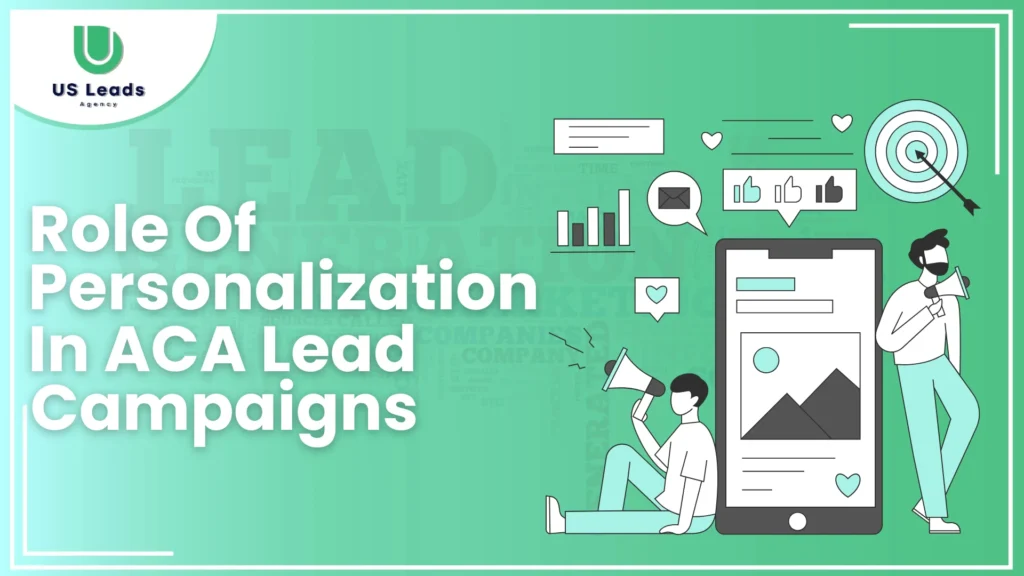
In today’s competitive digital marketing landscape, personalization is essential for Affordable Care Act (ACA) lead campaigns. A McKinsey report found that 71% of consumers expect personalized interactions, and 76% get frustrated when this doesn’t happen. For insurers, brokers, and marketers, tailoring messages to individual needs can significantly boost conversion rates and customer retention.
In this article, we will guide you the role of personalization in ACA lead campaigns.
Key Takeaways:
- Personalization enhances engagement and boosts conversion rates in ACA lead campaigns.
- Audience segmentation, AI tools, and omnichannel strategies improve outreach effectiveness.
- Ethical data usage and HIPAA compliance ensure trust and security.
- Marketers who embrace personalization gain a competitive edge in ACA lead generation.
Table of Contents
Understanding Role Of Personalization In ACA Lead Campaigns:
Personalization in ACA lead campaigns means customizing marketing efforts based on a consumer’s demographics, preferences, and behavior. It’s more than just adding a prospect’s name to an email, it’s about delivering relevant, timely content that guides them through enrollment.
Given ACA’s time-sensitive enrollment windows, personalized outreach helps address consumer concerns, educate them on plan options, and increase engagement compared to generic messaging.
Benefits of Personalization In ACA Lead Campaigns:
1. Higher Engagement Rates:
- Personalized emails and SMS see higher open rates and click-through rates than generic messages.
- Dynamic ads tailored to user interests increase ad performance.
2. Improved Conversion Rates:
- When consumers receive relevant information, they are more likely to act (e.g., filling out forms or completing enrollment).
- A HubSpot study found that personalized calls-to-action (CTAs) convert 202% better than generic ones.
3. Enhanced Customer Experience:
- Personalization builds trust and creates a sense of connection, making prospects feel valued.
- Consumers prefer brands that understand their needs.
4. Better ROI on Marketing Spend:
- Targeted messaging reduces wasted ad spend and increases campaign efficiency.
Strategies For Effective Personalization:
1. Audience Segmentation:
- Demographics: Age, income level, location, and health status.
- Behavioral Data: Past interactions, website visits, and enrollment history.
2. Leveraging AI & Automation:
- AI predicts consumer behavior and automates outreach for efficiency.
- Chatbots and AI assistants provide real-time, personalized support.
3. Creating Dynamic Content:
- Custom landing pages and emails adapt based on user preferences.
- Behavior-based retargeting keeps potential enrollees engaged.
4. Multi-Channel Engagement:
- Email, SMS, social media, and phone calls should deliver consistent messaging.
- Consumers engage more with brands that offer personalized omnichannel experiences.
Challenges & Considerations:
1. Data Privacy & Compliance:
- HIPAA regulations require strict handling of health-related data.
- Consumers must be informed about data collection and usage policies.
2. Getting Personalization Wrong:
- Poor personalization (irrelevant messaging) damages credibility and reduces engagement.
- Over-personalization can feel invasive, leading to lower trust levels.
3. Keeping Data Accurate:
- Outdated or incorrect data can lead to miscommunication and lower conversion rates.
- Marketers should regularly update and validate consumer data.
Conclusion:
Personalization in ACA lead campaigns isn’t optional, it’s a necessity. By integrating AI-driven insights, targeted messaging, and multi-channel engagement, marketers can enhance engagement, improve conversion rates, and deliver superior customer experiences.
As ACA enrollments evolve, businesses prioritizing personalization will outperform competitors in attracting and retaining leads.
FAQs:
How does data analytics enhance personalization in ACA marketing?
Data analytics predict consumer behavior, enabling marketers to deliver personalized content at the right time for better engagement.
What are the risks of personalization in ACA campaigns?
Risks include data privacy concerns, HIPAA compliance issues, and inaccurate data, all of which require strict management.
What tools can marketers use for ACA lead personalization?
Marketers can leverage CRM platforms, AI-driven analytics, and automation tools to optimize personalization.
Can personalization improve customer retention in ACA campaigns?
Yes, personalized experiences build trust and loyalty, increasing customer retention and plan renewals.
